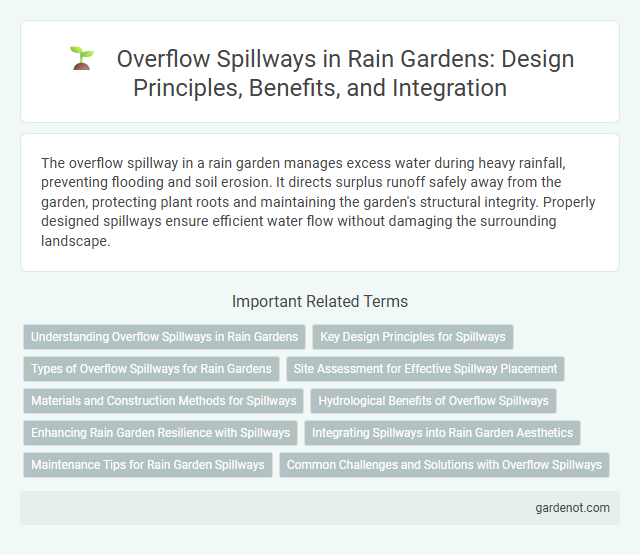The overflow spillway in a rain garden manages excess water during heavy rainfall, preventing flooding and soil erosion. It directs surplus runoff safely away from the garden, protecting plant roots and maintaining the garden's structural integrity. Properly designed spillways ensure efficient water flow without damaging the surrounding landscape.
Understanding Overflow Spillways in Rain Gardens
Overflow spillways in rain gardens are designed to manage excess stormwater by directing overflow safely away from the garden once the soil's infiltration capacity is exceeded. These spillways prevent flooding and erosion by channeling surplus water to storm drains or adjacent landscapes, ensuring the rain garden functions effectively during heavy rain events. Proper sizing and placement of overflow spillways are crucial for maintaining the structural integrity and long-term performance of rain gardens.
Key Design Principles for Spillways
An overflow spillway in a rain garden must be designed to handle peak stormwater flows, preventing flooding and erosion. Key design principles include sizing the spillway capacity based on the maximum expected rainfall intensity, ensuring materials are durable and erosion-resistant, and positioning the spillway at the appropriate height to maintain optimal water levels. Properly engineered spillways contribute to effective stormwater management by safely directing excess runoff away from the garden and surrounding areas.
Types of Overflow Spillways for Rain Gardens
Overflow spillways in rain gardens are essential for managing excess stormwater and preventing flooding. Common types include weir spillways, which use a flat edge to control overflow height, and pipe spillways that channel excess water through perforated pipes embedded within the garden. Level spreader spillways evenly distribute overflow water across a broad area to minimize soil erosion and encourage infiltration.
Site Assessment for Effective Spillway Placement
Effective overflow spillway placement in rain gardens requires thorough site assessment, including soil infiltration rates, topography, and existing drainage patterns to ensure proper water flow management. Identifying low points and natural water discharge areas helps position the spillway to prevent erosion and manage excess runoff during heavy rainfall. Accurate assessment reduces overflow damage and maintains rain garden functionality by directing surplus water safely away from the garden and nearby structures.
Materials and Construction Methods for Spillways
Overflow spillways in rain gardens are commonly constructed using durable materials such as concrete, stone, or reinforced earth to withstand variable water flow and prevent erosion. Installation involves careful excavation and grading to ensure proper alignment with the garden's drainage patterns, followed by secure placement of spillway materials with compacted soil or geotextile fabrics for stability. Utilizing modular precast concrete blocks or natural stone allows for both functional water conveyance and aesthetic integration within the rain garden landscape.
Hydrological Benefits of Overflow Spillways
Overflow spillways in rain gardens enhance stormwater management by directing excess water safely away during heavy rainfall events, preventing flooding and soil erosion. They reduce surface runoff and promote groundwater recharge, improving urban hydrology and water quality. Properly designed spillways optimize the absorption capacity of rain gardens, sustaining ecosystem health and minimizing infrastructure stress.
Enhancing Rain Garden Resilience with Spillways
Overflow spillways are essential components in rain garden design, effectively managing excess water during heavy rainfall events to prevent flooding and soil erosion. Integrating well-engineered spillways enhances rain garden resilience by directing surplus stormwater safely away from the garden, protecting plant roots and maintaining soil structure. Properly constructed spillways support sustainable urban drainage systems by improving water infiltration and reducing the risk of damage to nearby infrastructure.
Integrating Spillways into Rain Garden Aesthetics
Integrating overflow spillways into rain garden aesthetics enhances both function and visual appeal by using natural materials like stone or wood that blend seamlessly with native plantings. Designing spillways as sculptural features helps manage excess water efficiently while maintaining the garden's organic look. This approach ensures optimal stormwater control without compromising the rain garden's ecological and aesthetic value.
Maintenance Tips for Rain Garden Spillways
Regular inspection of the overflow spillway ensures efficient water flow and prevents clogging from sediment, leaves, and debris. Clearing debris promptly and trimming surrounding vegetation helps maintain spillway capacity and reduces erosion risks. Applying erosion-resistant materials around the spillway perimeter enhances durability and minimizes soil displacement during heavy rains.
Common Challenges and Solutions with Overflow Spillways
Overflow spillways in rain gardens frequently face clogging due to sediment and debris accumulation, which hampers water flow and causes localized flooding. Implementing regularly scheduled maintenance and installing removable grates or screens can effectively prevent blockages, ensuring consistent overflow function. Designing spillways with adequate slope and durable materials like concrete or heavy-duty plastic improves water conveyance while minimizing erosion risks.
Overflow spillway Infographic

 gardenot.com
gardenot.com